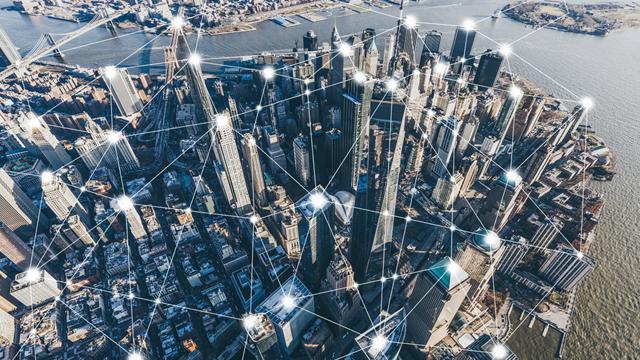What is a smart city?
Smart cities use information and communication technologies (ICT) to improve the ways they operate – from street lighting to public transport and more. Find out how digital technology promises to better connect us with our cities, help tackle climate change and create the urban environments of the future.
How does a smart city work?
Smart cities use connected digital technologies – also known as the ‘internet of things’ (IoT) – to optimise the functions that support how we live in urban environments.
These technologies use artificial intelligence or machine learning to build data sets, which can identify where optimisations can be made in real time. Put together, they can create an infrastructure framework that addresses different urban challenges, while considering the knock-on effect they’ll have on other systems.
What makes a city ‘smart’?

There are several defining characteristics for what makes a city ‘smart’:
- Having an infrastructure that uses connected digital technologies at its heart
- Using connected technology to improve environmental and sustainability criteria
- City planning that is progressive in terms of use of space, resource and energy
- Public transportation and traffic systems that are highly efficient
- Urban space that is hospitable to a citizen’s day-to-day life
In practice, these characteristics affect everything from traffic and transportation systems to waste management, crime detection and public health, and how they work.
Advantages and disadvantages of a smart city
Smart cities can improve every facet of city living for their residents. The benefits can include: cleaner air and less pollution; faster and more available public Wi-Fi; better community engagement; less traffic and congestion; crime reduction through advanced surveillance systems; and, cheaper energy bills.
However, smart cities don’t come without a cost; the upgrade of even one component, such as a public transportation system, can cost the taxpayer billions and can take years to implement. The government and public sector must be in agreement on these costs and timescales, or risk a project’s collapse in the future – which could result in a political and civic catastrophe.
Despite higher costs footed by the taxpayer in the short term, the benefit to a citizen’s wellbeing, health and overall comfort promise to make it worth it. This is especially important when you consider that more than 85% of the world’s population are set to live in cities by 2050.1
The top five smart cities in the world
These five cities are considered the most advanced in how connected technologies integrate into their urban infrastructure:
5. London
Highly regarded for its total connectivity and efficient public transport network, new civic initiatives are funding start-ups to find solutions towards future urban challenges.
4. Dubai
The city has completed a seven-year plan to digitally transform all government and economic services, which citizens can access through the DubaiNow app.
3. Amsterdam
The use of the city’s myriad waterways to alleviate overcrowding and the open-source approach to urban planning are just some of the reasons the Dutch capital is one of the smartest cities in the world.
2. Singapore
Smart technologies have long been used in Singapore to raise productivity and economic prosperity in the country. Now, a 2022 government initiative is looking at increasing energy efficiency by installing thousands of rooftop solar panels and low-energy street lighting.
1. New York City
One of the best cities in the world in terms of connectivity, new initiatives are being rolled out to improve New York’s ageing subway system, improve waste management and create better civic services. Natural habitats are also being reintroduced into the city by repurposing disregarded real estate.
The future of the smart city
Experts predict that one of the greatest roles smart cities will play is in the reduction of emissions such as carbon dioxide (CO2) from our atmosphere – a crucial aspect of tackling climate change and reaching net zero carbon emissions.
And, as our cities currently consume 78% of the world’s energy and produce more than 60% of its greenhouse gases2, it will be crucial to see how citywide initiatives use low- and zero-carbon technologies at a domestic level, especially if we’re to reach net zero by 2050.
1 TWI Ltd: What is a smart city? – definition and examples
2 United Nations: Climate Action – Generating power
Last updated: 20 Jun 2020
The information in this article is intended as a factual explainer and does not necessarily reflect National Grid's strategic direction or current business activities.



